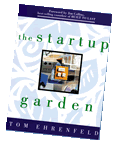
Just Managing: Focus! Focus! Focus!Business schools teach many complex lessons, such as how to structure a deal or how to analyze the net present value of a resource, but one of the most important lessons is also one of the simplest: focus. Time and again, would-be entrepreneurs are reminded to keep their business plans rigidly targeted on a clear and achievable goal - not to seek the grand vision of changing the world - and to keep their goals clear, distinct and realizable. Dan Roth, 28, the boyishly enthusiastic CEO of Voice Signal Technology, a startup in Cambridge, Mass., that develops voice-recognition technology, attests to the value of this simple lesson. He believes that focus, coupled with his second core tenet - "Whatever you set out to do, whether grand or granular, you finish it" - accounts for his company's success. Roth formed Voice Signal with his college friend Tom Lazay when they were seniors at Trinity College in 1995. They chose the field of voice recognition based on a big dream: A friend of theirs had just become paralyzed from the waist down, and they wanted to form a company that could help her out. They began researching, yet as Roth and Lazay learned more, they were forced to scale back their vision. At the time, the market for assisted technology was too small, and their plan was too ambitious. To develop a commercially viable technology would have required more money and expertise than they had available. They chose instead to focus on a market they felt was being ignored at the time: voice-recognition applications for small consumer products, such as lights, thermostats and toys. Large companies such as Dragon Systems were building related systems for dictation, a task that required enormous amounts of sophisticated computing power because the systems have to be able to recognize a huge vocabulary. Voice Signal wanted a system that would recognize only a limited amount of commands. Neither Roth nor Lazay are technology geniuses, but they are crafty. They hired developers to produce their first system, an effort that was essentially disastrous. Roth calls the first prototype a "random-activity generator" because, he quips, "When the dog barked, the phone would ring." Undaunted, the two pressed on. With the prototype, their business plan and their nascent contacts, they were able to raise $250,000 and hire their first serious technology officer, Igor Zlokarnik, a veteran of Los Alamos, N.M., who had seen their job posting on Monster.com. Roth says they were able to land Igor because he believed in their vision and was particularly excited about the prospect of being able to control his own research. Clearly, they had developed their sales ability by then - Roth was still living at his parent's house and conducted Zlokarnik's interview in their living room. Hiring Igor was a shot in the arm for the young company, something akin to Keith Moon joining The Who. Before long, they had made significant technological breakthroughs by borrowing from fields outside speech recognition. The company then spent four arduous months hammering out an agreement to license their technology to a major electronics company, only to have the agreement fall through at the last minute. But Roth and his partners were undeterred. "The fact that we had made the product successful made us realize how valuable the software had become," Roth says. Soon, he and Lazay struck several deals, including one with GE Appliances and another with appliance distributor Salton. Focus dictated the structure of the company and its strategy. Rather than managing the entirety of product development, the company went the licensing route, a decision that reduced the amount of capital spent, outsourced manufacturing nightmares and leveraged its resources.
Today, the company is a leader in affordable speech-recognition technology. Earlier this year, it raised $8.4 million in venture money. In August, it announced a speech-recognition system for interactive toys, which costs less than $2 per unit. It now offers a range of products that respond to specific voice commands, and Roth is confident that over time, the technology will apply to a broad range of devices from cell phones to mobile-computing devices. An ambitious line of products, to be sure, but one that was born out of a clear focus. |
THE BOOK Read or print the Intro and Chapter 1. Read the book reviews at Inc and 1-800-CEO-READ. Read the publisher's press release. Buy this book from Amazon.com. Visit the companies that Tom discusses in the book Hear a recent lecture by Tom on the Startup Garden STARTUP KIT Buy my book and I will send you a worksheet and list of local and industry resources for your startup. Simply send me an email with your zip code and type of company and I will email you the free kit. Thanks! TOM'S WRITING Just Managing – articles that Tom wrote for The Industry Standard and some Business Articles written for Inc., Fortune Small Business, Harvard Management Update, and other places. RESOURCES Read about other books and web sites about starting your own business. |
| © 2001-2003 Tom Ehrenfeld | Site design by Tim Swan | |
